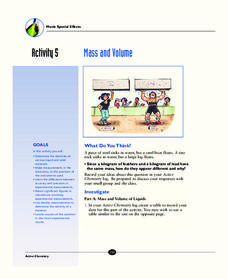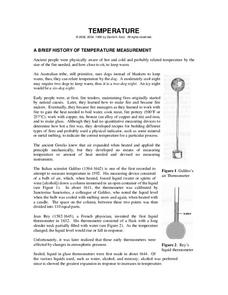Curated OER
Capillary Action
In this capillary action worksheet, learners follow directions to see the ability of liquids being drawn up into small spaces using beakers, paper, rulers, food coloring and more. Students follow 8 sets of directions and write a conclusion.
Noyce Foundation
Time to Get Clean
It's assessment time! Determine your young mathematicians' understanding of elapsed time with this brief, five-question quiz.
Curated OER
The Burette
In this burette use worksheet, students are given directions for performing a titration using a burette. Students practice reaching the end-point oftitrations and they calculate the mean volume of three trials.
Curated OER
Units of Measure
In this metric units of measurement worksheet, students read information about estimating lengths and masses, then solve 65 problems. Sample problems with solutions are included.
Texas State Energy Conservation Office
Investigation: Gas Laws in Action - Propane
Using helium as an example of propane, physical science middle schoolers experiment with and graph the relationship between temperature and volume in gases. In a whole-class demonstration, they show how molecules behave under different...
Curated OER
Investigating Osmosis
A thorough investigation of cell transport is provided when completing the assignment. The first half requires biology class members to answer questions about diffusion and osmosis with the aid of diagrams. Then they fashion an...
It's About Time
Mass and Volume
Don't be so dense that light bends around you; study the relationship between mass and volume instead. Young chemists measure the density of a variety of liquids and solids. A reading passage and analysis questions introduce pupils to...
It's About Time
Volcanic Hazards: Flows
Did you know the largest volcano in our solar system is on Mars? Young scholars measure and experiment with how to predict lava and mud flows. This knowledge leads to better evacuation, safety, and preventative methods.
Curated OER
The Scientific Method
For this scientific method worksheet, students read over the basic steps of the scientific method and then apply those steps to a specific example. This worksheet has 8 short answer questions.
Chymist
Temperature
Three Dog Night isn't just the name of a band; it is also the way an Australian tribe, who used dogs to stay warm, would describe the temperature on a cool evening. After reading about many different ways of measuring temperature, the...
Chymist
The Solubility of a Salt in Water at Various Temperatures
An educational activity allows young chemists to test the solubility of different types of salt at various temperatures. Groups create a graph using data from unsaturated, saturated, and supersaturated solutions.
Curated OER
Classification of Matter
This is a great instructional activity with an infographic to assist your high schoolers in categorizing matter into mixtures and non-mixtures. Information is given about the metric system of measurement. Your young students match 13...
Houghton Mifflin Harcourt
Customary Units of Capacity - Problem Solving 12.3
Math majors need not only to be able to solve problems, but also apply the skills to real-world situations. On this activity, they solve five problems in which they must convert units of capacity or liquid volume. Give this to your class...
Messenger Education
Cooling with Sunshades
Messenger's sun shade measures 8 ft x 6 ft and will have temperatures reaching 700 degree Fahrenheit on the outside while maintaining a cool 70 degrees underneath. In the third activity of four, groups discuss the basic properties of...
Rivanna Regional Stormwater Education Partnership
Invisible Passengers
How does water pollution affect the organisms living in the water? Use three science experiments to examine how erosion and other pollutants can affect water quality. Each experiment focuses on a different aspect of pollution and...
Marine Institute
Water Pollution
Sixth graders investigate the various types of pollutants found in water and ways to help prevent water pollution. Through a hands-on experiment, students create samples of polluted water by mixing water with vegetable oil, dirt, and...
Curated OER
Fuel Cell Experimentation
With rising oil prices and increasing concerns over global warming, the pressure is on for engineers to develop alternative sources of energy. Among the new technologies being developed are hydrogen fuel cells, which young scientists...
Curated OER
Sunshine Math 3
In this word problems worksheet, learners read and problem solve nine mathematical word problems involving grids, measurement, compensation and angles.
Teach Engineering
Quantum Dots and Colors
Introduce teams to quantum dot solutions with an activity that has them expose solutions to a blacklight, observe the colors, and take measurements. Groups graph the data and analyze the dependence between particle size and color...
Houghton Mifflin Harcourt
Metric Units of Capacity - Practice 12.8
You will appreciate a useful worksheet for grasping an understanding of liquid volume and practicing metric unit conversions. All of the problems involve liters and milliliters, so the conversions are very elementary. Neat drawings of...
Texas State Energy Conservation Office
Investigation: Heat it Up!
This demonstration of solar ponds can be used in an earth, environmental, or physical science setting. Lab groups set up a solar pond and model how it is able, due to a salt concentration gradient, to maintain heat for future use.
Curated OER
Breaking News English: Airports Ban Liquids on Planes
In this English worksheet, students read " Airports Ban Liquids on Planes," and then respond to 47 fill in the blank, 7 short answer, 20 matching, and 8 true or false questions about the selection.
Curated OER
Breaking News English: Airports Ban Liquids on Planes
In this English worksheet, students read "Airports Ban Liquids on Planes," and then respond to 47 fill in the blank, 7 short answer, 20 matching, and 8 true or false questions about the selection.
Curated OER
Time to lend NASA a hand
In this measurement activity, students complete an experiment answer questions about how they measure the units of volume, temperature, and mass of certain objects. Students answer 5 questions.

























